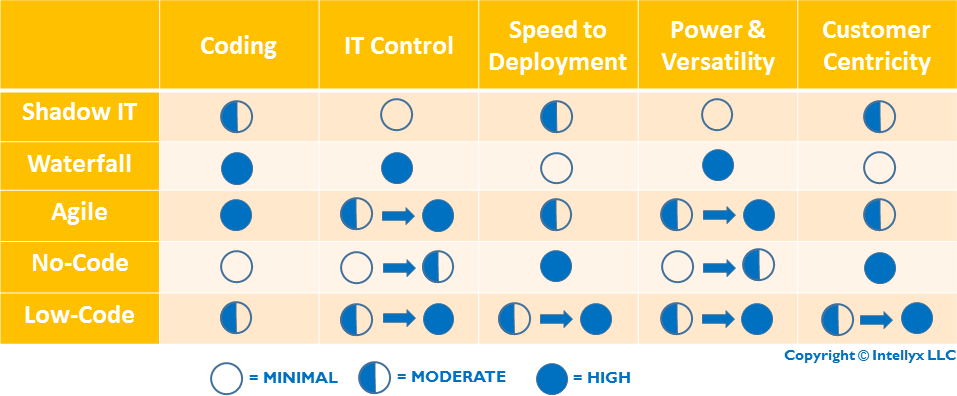As enterprises reacted to the drawbacks of traditional, waterfall development – long timeframes, high costs, and results that rarely met customer expectations – they had to make a critical choice: move to Agile development approaches within IT, or build and support applications outside IT altogether – what we’ve come to call shadow IT.
Business users, fed up with slow, intractable IT organizations, often felt their best option was shadow IT. Outside of the IT organization, applications were faster to deploy with less coding than IT-driven application development – but devoid of any IT control that would ensure security, compliance, and integration to back-office systems.
Agile approaches also addressed the shortcomings of waterfall, as well as delivering far more powerful applications than shadow IT could deliver. Furthermore, Agile allowed for greater IT control than shadow IT, while providing greater customer-centricity than waterfall approaches – at least in theory.
However, almost two decades have passed since Agile came on the scene, and enterprises still struggle to get consistent value from Agile methodologies.
To fill this void, the Low-Code and No-Code movements have largely built upon both the Agile and shadow IT trends. Low-Code delivers greater power and speed to development teams within the IT organization, while No-Code platforms and tools targeted at business users or ‘citizen developers’ offer greater deployment speed and customer-centricity than shadow IT solutions, while allowing for some measure of IT control.
Today all five approaches remain, from the shadow IT and waterfall techniques of the past, to modern Agile and Low-Code/No-Code approaches. The end result: broad confusion over the pros and cons of the various approaches, even as Low-Code/No-Code products mature.
Comparing the Benefits of the Various Approaches
To help clear up this confusion, I’ve put together the following chart, comparing five essential characteristics across the five application creation approaches discussed above.

Comparing the Benefits of Different Application Creation Approaches
The primary lesson of the chart above is how organizations have historically traded off IT control with the benefits of speed to deployment and power and versatility. However, as Low-Code platforms mature, such companies are finding they can achieve all of these priorities at the same time.
Even Agile approaches are not able to deliver this diverse a value proposition. Agile clearly offers greater speed to deployment and customer centricity than waterfall does. In many organizations, however, Agile struggles in two key areas: IT control and power and versatility, especially as organizations scale up their Agile efforts.
For Agile to step up to the plate in these two areas, organizations must provide some level of overall structure to Agile initiatives, either through a framework like the Scaled Agile Framework (SAFe), or via the appropriate involvement of enterprise architecture.
No-Code solutions do not always provide the range of benefits that Low-Code platforms promise either. Where some No-Code tools suffer is in the areas of IT control as well as power and versatility, thus suggesting that No-Code can lead to shadow IT issues.
As a result, the vendors in the No-Code space are actively innovating in order to address such shortcomings – some more successfully than others. Delegating application creation to citizen developers while expecting IT to maintain sufficient control, however, remains a difficult challenge.
While No-Code solutions struggle to distance themselves from shadow IT, Low-Code platforms tend to follow the pattern of Agile approaches – only with less coding required. There is an important difference between the two, however: Agile is a family of methodologies while Low-Code is a platform with commensurate tooling.
Thus, while organizations must change their approaches to address the issues with Agile, the responsibility for improvements with Low-Code platforms largely falls to the vendors. As these platforms and tools mature, they become easier and more powerful, and application deployment becomes faster and more customer-centric.
Perhaps the most important area of innovation among the Low-Code platform players is support for greater IT control, without having to trade off speed-to-deployment and customer centricity. To address this tradeoff, a new class of Low-Code platform like BlueFabric from AGYS tackles the IT control challenge head-on.
In the case of BlueFabric, its history as a business process-centric application platform enables it to support the Low-Code implementation of governance processes, handling difficult challenges like change management within the core functionality of the platform itself.
BlueFabric thus offers greater levels of IT control to its customers while trading off neither speed to deployment nor customer centricity – an important result for highly regulated enterprises or any organization that requires high levels of IT control over application creation and deployment.
The Intellyx Take
As the bottom row of the chart above illustrates, the Low-Code space is the most dynamic of all the application creation approaches enterprises are likely to undertake. As one might expect, the products in this market segment are all works in progress.
Nevertheless, the chart highlights an important prediction: as Low-Code platforms mature, they will offer higher scores across the board, something none of the other approaches promise – while requiring less hand-coding than either traditional or Agile techniques.
Copyright © Intellyx LLC. AGYS is an Intellyx client. At the time of writing, none of the other organizations mentioned in this article are Intellyx clients. Intellyx retains full editorial control over the content of this paper. Image credit: Intellyx.



